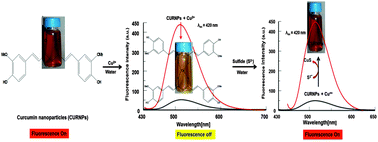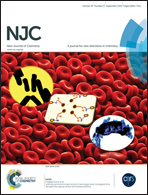A highly selective and sensitive single click novel fluorescent off–on sensor for copper and sulfide ions detection directly in aqueous solution using curcumin nanoparticles†
Abstract
Based on curcumin nanoparticles (CURNPs) in the aqueous system a fluorescent nanosensor was prepared by a simple reprecipitation method and characterized. It can display off-type fluorescence with high selectivity toward Cu2+ among other metal ions in aqueous solution having an excellent detection limit. Furthermore, the in situ generated CURNPs–Cu2+ ensemble could recover the quenched fluorescence upon the addition of S2− resulting in an on-type sensing with a detection limit in the nanogram range in the same medium, which overcomes the detection limit of the method reported in the literature. No interference was observed from other anions, making it a highly sensitive and selective sulfide probe. The fluorescence lifetime, particle size and zeta potential studies of CURNPs with and without Cu2+ and S2− helped to propose a suitable mechanism of fluorescence ‘off–on’ of nanoparticles by Cu2+ and S2−. In addition, the stoichiometry and binding ability of CURNPs during complexation with Cu2+ was estimated by Job's, Hill's and Benesi–Hildebrand plots. The fluorescence ‘off–on’ results are used further to develop analytical methods for estimation of Cu2+ and S2− ions from environmental water samples without any interference.



 Please wait while we load your content...
Please wait while we load your content...